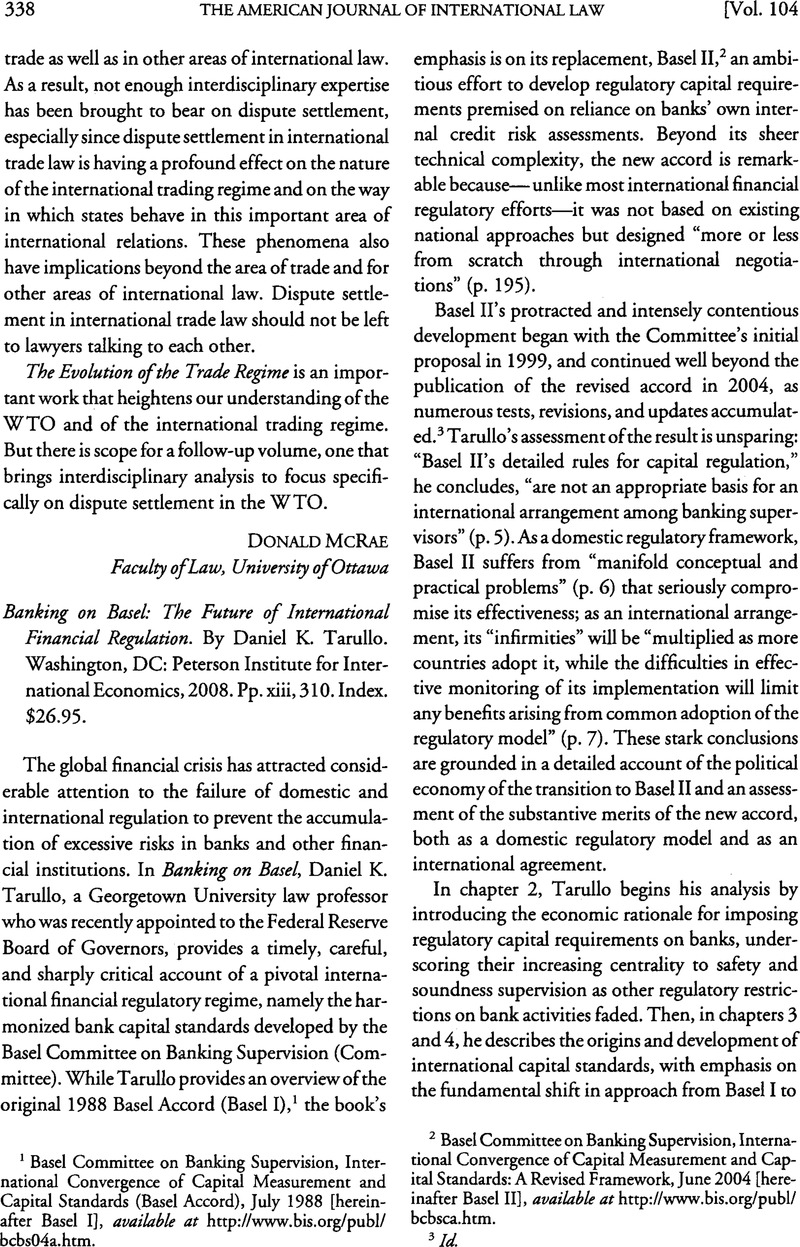No CrossRef data available.
Article contents
Banking on Basel: The Future of International Financial Regulation. By Daniel K. Tarullo, Washington, DC: Peterson Institute for International Economics, 2008. Pp. xiii, 310. Index. $26.95.
Published online by Cambridge University Press: 27 February 2017
Abstract

- Type
- Recent Books on International Law
- Information
- Copyright
- Copyright © American Society of International Law 2010
References
1 Basel Committee on Banking Supervision, International Convergence of Capital Measurement and Capital Standards (Basel Accord), July 1988 [hereinafter Basel I], available at http://www.bis.org/publ/bcbs04a.htm.Google Scholar
2 Basel Committee on Banking Supervision, International Convergence of Capital Measurement and Capital Standards: A Revised Framework, June 2004 [hereinafter Basel II], available at http://www.bis.org/publ/bcbsca.htm.Google Scholar
3 Id.
4 Very generally, each asset held by a bank would be assigned a specific risk weight based on its classification under the accord. For instance, most commercial loans were assigned a 100% weight; most residential mortgage loans, 50%; and debt of Organisation for Economic Co-operation and Development (OECD) sovereigns, 0%. For each asset, banks would have to maintain capital equal to at least 8% of the risk-weighted value of the loan, i.e., its principal amount times the appropriate risk weight. Basel I also included a provision for assigning risk weights to contingent and other off-balance sheet liabilities (such as guarantees), and was amended in 1996 to institute capital requirements in respect of market risk related to financial instruments in the “trading book.”
5 More specifically, Basel II incorporates two “internal ratings based” (IRB) approaches. The “advanced” version (A-IRB), intended to apply to the largest and most sophisticated banks, allows banks to determine internally more of the statistical risk indicators that serve as inputs for the regulatory capital formula than the “standard” IRB approach. Importantly, in both versions, the actual capital requirement is not determined directly by the banks but by processing these internally derived inputs through the formula prescribed by the accord. Basel II also includes a “standardized” approach intended for smaller banks. That approach is essentially a revised version of the Basel I methodology that attempts to produce more precise risk weightings by relying on credit agency ratings.
6 Anne-Marie, Slaughter A New World Order 167 (2004)Google Scholar; see also Kal, Raustiala The Architecture of International Cooperation: Transgovernmental Networks and the Future of International Law , 43 Va. J. Int’ll. 1, 51 (2002).Google Scholar For a critical perspective on regulatory networks, see Pierre-Hugues, Verdier Transnational Regulatory Networks and Their Limits , 34 Yale J. Int’ll. 113 (2009).Google Scholar
7 Michael, S. Barr & Geoffrey, P. Miller Global Administrative Law: The View from Basel , 17 Eur. J. Int’ll. 15, 17 (2006).Google Scholar
8 See, e.g., Kenneth, W. Abbott & Duncan, Snidal Hard and Soft Law in International Governance , in Legalization and World Politics 37 (Judith, L. Goldstein et al. eds., 2001)Google Scholar; Charles, Lipson Why Are Some International Agreements Informal? A1) Int’l Org. 495 (1991)Google Scholar.


